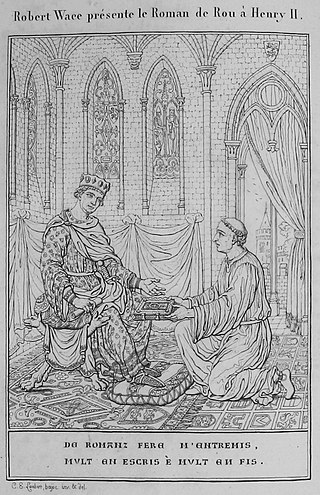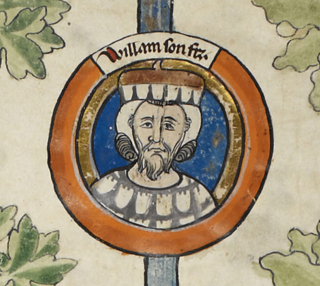Related Research Articles

Rollo was a Viking who, as Count of Rouen, became the first ruler of Normandy, a region in today's northern France. He emerged as a leading warrior figure among the Norsemen who had secured a permanent foothold on Frankish soil in the valley of the lower Seine after the Siege of Chartres in 911. Charles the Simple, king of West Francia, granted them lands between the mouth of the Seine and what is now Rouen in exchange for Rollo agreeing to end his brigandage, swearing allegiance to him, religious conversion and a pledge to defend the Seine's estuary from other Viking raiders.

Robert I of Normandy, also known as Robert the Magnificent and by other names, was a Norman noble of the House of Normandy who ruled as duke of Normandy from 1027 until his death in 1035. He was the son of Duke Richard II; the brother of Duke Richard III, against whom he unsuccessfully revolted; and the father of Duke William who became the first Norman king of England after winning the Battle of Hastings in 1066. During his reign, Robert quarrelled with the church—including his uncle Robert, archbishop of Rouen—and meddled in the disorder in Flanders. He finally reconciled with his uncle and the church, restoring some property and undertaking a pilgrimage to Jerusalem, during which he died.

Richard II, called the Good, was the duke of Normandy from 996 until 1026.
Alan III of Rennes was Count of Rennes and duke of Brittany, by right of succession from 1008 to his death.

Richard I, also known as Richard the Fearless, was the count of Rouen from 942 to 996. Dudo of Saint-Quentin, whom Richard commissioned to write the "De moribus et actis primorum Normanniae ducum", called him a dux. However, this use of the word may have been in the context of Richard's renowned leadership in war, and not as a reference to a title of nobility. Richard either introduced feudalism into Normandy or he greatly expanded it. By the end of his reign, the most important Norman landholders held their lands in feudal tenure.
Dudo, or Dudon, was a Picard historian, and dean of Saint-Quentin, where he was born the 960s. He was an erudite scholar and he likely acquired his education in Liège or perhaps Laon. By 987, Dudo had become a canon at St Quentin, the abbacy of which was held by the counts of Vermandois. In that year he was sent on a diplomatic mission to Richard I of Normandy by Albert I, Count of Vermandois which was successful. Dudo became a frequent visitor to the Norman court in the two years prior to Richard's death in 996. In a letter to Adalbero, Bishop of Laon, Dudo said that, as a result, Richard asked him to write a work recording "the customs and deeds of the Norman Land, the rights established within the kingdom of his great-grandfather Rollo". During a second stay in Normandy, Dudo wrote his history of the Normans, a task which Duke Richard had urged him to undertake. Very little else is known about his life, except that he died before 1043.

Gesta Normannorum Ducum is a chronicle originally created by the monk William of Jumièges just before 1060. In 1070 William I had William of Jumièges extend the work to detail his rights to the throne of England. In later times, Orderic Vitalis and Robert of Torigni, extended the volumes to include history up until Henry I.

Roman de Rou is a verse chronicle by Wace in Norman covering the history of the Dukes of Normandy from the time of Rollo of Normandy to the battle of Tinchebray in 1106. It is a national epic of Normandy.

Robert of Torigni or Torigny, also known as Robert of the Mont, was a Norman monk, prior, and abbot. He is most remembered for his chronicles detailing English history of his era.

William of Jumièges was a contemporary of the events of 1066, and one of the earliest writers on the subject of the Norman conquest of England. He is himself a shadowy figure, only known by his dedicatory letter to William the Conqueror as a monk of Jumièges. Since he also mentions that he was an eyewitness of some events from the reign of Duke Richard III (1026-7), it seems reasonable to assume that he was born some time about the year 1000. He probably entered the monastery during the first quarter of the eleventh century and received his education from Thierry de Mathonville. According to Orderic Vitalis, William's nickname was "Calculus". The meaning behind this nickname is unknown. His death, after 1070, is unrecorded. He was a Norman writing from a Norman point of view. Although only a monk with evidently no military training, he wrote with pride in the accomplishments of his people.

William Longsword was the second ruler of Normandy, from 927 until his assassination in 942.
Theobald I, called the Trickster, was Count of Blois, Tours, Chartres and Châteaudun, as well as Lord of Vierzon and Provins. He was a loyal and potent vassal of Hugh the Great, duke of the Franks.
Étienne de Rouen, also Stephen of Rouen and Latin: Stephanus de Rouen, was a Norman Benedictine monk of Bec Abbey of the twelfth century, and a chronicler and poet.
Bernard the Dane is described by the tenth century ecclesiastical writer Dudo of Saint-Quentin as a 'warrior' of Rouen from 'Dacia', an ally and confidant of the first leaders of Normandy, political counsellor to Rollo's son William Longsword, and co-regent of the territory during the minority of his son and heir, Richard I of Normandy. In particular, Bernard is seen as being at the centre of events in the aftermath of the assassination of William Longsword.
Anslech or Anslec de Bricquebec played a major political role in the first days of the duchy of Normandy, though the sources on him are rather opaque.
John of Avranches was bishop of Avranches from 1060 to 1067, and archbishop of Rouen from 1067 to 1079. He was a Norman churchman, son of Rodulf of Ivry, and brother of Hugh of Bayeux. He appears in the Gesta Normannorum Ducum of William of Jumièges, and may have been one of the sources William used.
The phrase more danico is a Medieval Latin legal expression which may be translated as "according to Danish custom", i.e. under Medieval Scandinavian customary law.
Sprota was an early 10th century woman of obscure origin who became wife 'in the Viking fashion' of William I, Duke of Normandy, by her becoming mother of his successor, Duke Richard I. After the death of William, she married a wealthy landowner, Esperleng, by him having another son, Norman nobleman Rodulf of Ivry.
Hagrold, also known as Hagroldus, Harold, and Harald, was a powerful tenth-century Viking chieftain who ruled Bayeux. He was apparently a pagan from Scandinavia, and seems to have seized power in Normandy at about the time of the death of William, Count of Rouen. His career can be interpreted in the context of aiding the Normans against the intrusion of Frankish authority, or conversely in the context of taking advantage of the Normans.

Louis IV, called d'Outremer or Transmarinus, reigned as King of West Francia from 936 to 954. A member of the Carolingian dynasty, he was the only son of king Charles the Simple and his second wife Eadgifu of Wessex, daughter of King Edward the Elder of Wessex. His reign is mostly known thanks to the Annals of Flodoard and the later Historiae of Richerus.
References
- ↑ Dudo of Saint-Quentin, De moribus et actis primorum Normanniae ducum, Ed. Jules Lair, Caen, F. Le Blanc-Hardel, 1865, p.220
- ↑ Wace and Benoît de Saint-Maure, Roman de Rou, ed. Le Prévost et Langlois, 1827, p.109
- ↑ William of Jumièges, History of the Normans, ed. Guizot, Brière, 1826, Livre IV, p.79 (French translation of Gesta Normannorum ducum written c.1172)
- ↑ The Battle Abbey Roll: With Some Account of the Norman Lineages, Volume 3, edited by Catherine Lucy Wilhelmina Powlett, Duchess of Cleveland (London: John Murray, 1889) pp. 162-164 https://www.geni.com/people/Raoul-d-Angers-d-Anjou/6000000003828254957
- ↑ Ye'or, Bat; Kochan, Miriam and Littman, David (2002) Islam and Dhimmitude: Where Civilizations Collide Fairleigh Dickinson University Press, Madison, NJ, p. 63 ISBN 0-8386-3942-9